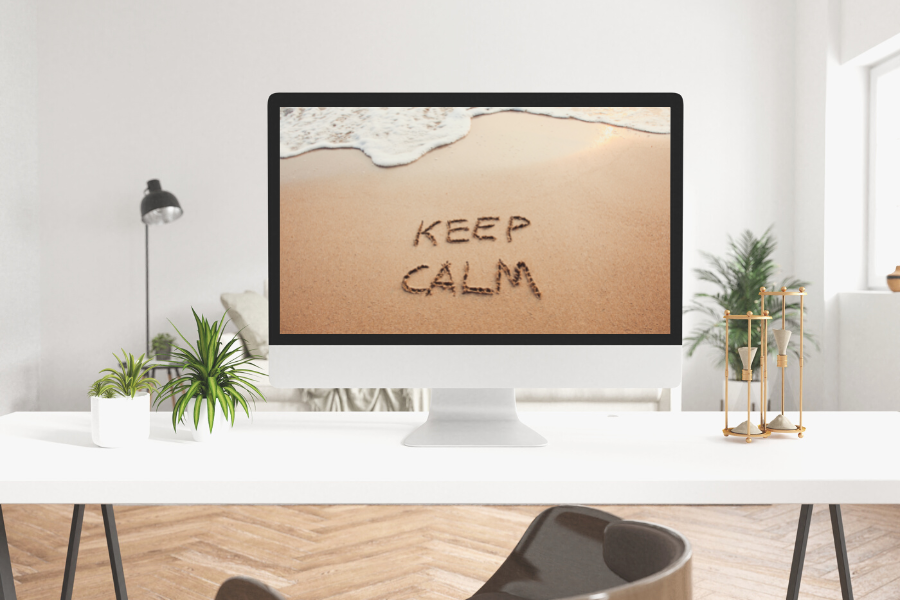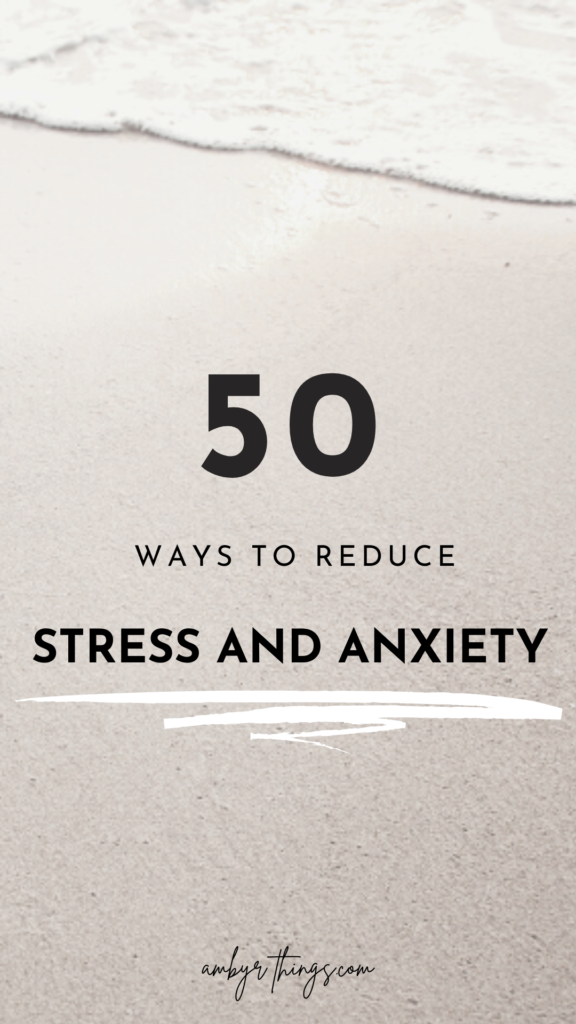Free yourself from overthinking and self-doubt during stressful and anxious moments. Regardless of the source, these tips can help you think more clearly and regain control faster.

Experiencing stress and anxiety, especially while making major changes to your life, is completely normal.
In fact, everyone will have these experiences at some point, regardless of their best intentions or circumstances.
But no matter how crippling those moments can feel, calming your mind and maintaining control is completely possible.
As someone who’s experienced stress and anxiety, I know how critical it is to address the symptoms before they escalate.
So, that’s why I’m sharing the exact strategies I’ve found helpful in keeping doubt, negative self-talk, and self-criticism under control.
In this post, you’re going to learn about stress and anxiety, symptoms to look out for, and how to regain control so that you’re no longer a victim.
50+ WAYS TO RELIEVE STRESS AND ANXIETY

WHAT ARE SOME COMMON SIGNS OF STRESS AND ANXIETY?
Anxiety and stress are related but different concepts.
Stress is a natural response to a perceived threat or challenge, while anxiety is a more intense and persistent emotional response to a perceived threat.
Check out common symptoms below:
Physical Signs:
Stress: Headaches, sleep disturbances, chest pain, changes in appetite.
Anxiety: Sweating, shaking, or trembling.
Both: Increased heart rate, muscle tension, shortness of breath, gastrointestinal problems, fatigue.
Emotional Signs:
Stress: Anxiety, mood swings, feeling overwhelmed, feeling down or depressed.
Anxiety: Worry, fear, or difficulty concentrating.
Both: Irritability, restlessness, a sense of impending doom.
Mental Signs:
Stress: Difficulty concentrating, forgetfulness, indecisiveness.
Anxiety: Repetitive or intrusive thoughts, *excessive worrying.
Both: Racing thoughts, worrying.
Behavioral Signs:
Stress: Social withdrawal, substance abuse, procrastination, increased or decreased appetite.
Anxiety: Avoidance of anxiety-triggering situations, seeking reassurance from others, and also restlessness.
Both: Nervous habits (nail-biting, teeth-grinding, pacing), and difficulty completing tasks.

MUST READ: REDUCE ANXIETY WITH THIS NIGHT TIME ROUTINE
HOW DO I KNOW IF I’M STRESSED
OR IF I’M ANXIOUS?
As indicated above, there is a lot of overlap when it comes to the symptoms of stress and anxiety.
But below is a simple way to tell the difference.

Stress = basically an external event (disagreements, deadlines, goals, changes to household, relationships, job, daily life, or weight)
Anxiety = if the thoughts are constant and intrusive even when the stressor has been removed
HERE’S HOW YOU CAN BEGIN
TO REGAIN CONTROL
Now that you understand the difference between stress and anxiety, and also some common symptoms, try using the 4 steps below to help redirect your focus.

1. Create space
Walking away is the easiest and safest bet when you’re feeling anxious or stressed. Not only does this create distance between you and the challenge, but it also preserves the remaining control you have.
Physically create space between you and the challenge. Whether it’s a phone call, individual, slide deck, text messages, dirty dishes, etc. Simply walk away.
2. Name it
When you walk away, go to a quiet place where you can feel safe and vulnerable. (I.e., your car, a closet, or even the bathroom). Once you’re there, close your eyes and mentally acknowledge whether you’re feeling stressed, anxious, or both.
3. Identify the trigger
While it might seem ineffective, there’s power in naming and identifying what is bothering you.
Ex. I am having a [stressful or anxious] moment because I am [worried/ concerned about, or bothered by] [this specific thing]
4. Redirect
Once you know what you’re dealing with, reframe the experience by redirecting your mind towards something else.
This part of regaining control helps you override usual thinking patterns, and also behaviors your brain is used to.

Here Are 50+ Things You Can Do To Relieve Stress And Anxiety
- Do something creative– Download an adult coloring app, draw art in Procreate, write a poem, read a book in a different genre, take a different route home from work, do a fun journal prompt, paint your nails.
- Do something challenging – Play a game of Sudoku or Words With Friends, try to beat a new level in a video game, write a blog post in 30 minutes, run at full speed on a treadmill, attend a Pilates class.
- Do something musical – Play guitar hero, sing karaoke on the Smule App, turn your music all the way up, drive around and listen to a new album, dance to slow jams, listen to elevator music on YouTube, make a new beat!
- Do something productive – Write your business plan, create a list of SMART goals, order your groceries from a delivery app, load the dishwasher, do laundry, listen to a podcast related to your dream, put your phone on silent & DND, update your resume, update your to-do list.
- Do something fun – Dance, Facetime, play The Sims, watch 2 episodes of your favorite show, play intramural sports, make a TikTok, crawl around with your kids, play multiplayer games with your friends, watch something funny.
- Do something calming – Stretch your neck, back and shoulders, take a siesta , sit outside and enjoy a cup of green tea with lemon, recite affirmations, pray, put on loose clothing, talk with your therapist or coach, take a warm bath or shower.
- Do something confident – Go to the gym, sign up for a dating app, read this article, do an at home facial, add connections from your dream company on LinkedIn, get dressed up, complete a challenge.
- Do something reflective – Pray for strength and wisdom, journal about a time when you surprised yourself, go for a casual stroll outside, sit in the car a bit longer before heading inside, do yoga, 15 minutes in the Calm or Headspace apps.
- Do something vulnerable – Ugly cry, scream into a pillow, go radio silent, ask for help , deactivate your social media accounts, practice restraint, remove something from your plate or TDL, delegate to others, ask for a hug, high-five yourself in the mirror, choose rest.
- Lastly, allow yourself to be human – That’s all ♡
5. SOLVE THE PROBLEM
So, by now, you know a ton of strategies to help redirect your mind away from stress and anxiety. Once the coast is clear and your shoulders are back to their natural, relaxed state, revisit the challenge and try to solve the problem.

Answer this question: What is another way to solve this problem or have a better experience?
Then, confidently take the steps to do so or seek help where appropriate.
Remember, stress typically subsides when the stressful event is over. Anxiety, on the other hand, can happen any time, even when the stressor has been resolved.
It’s important to recognize these symptoms and seek help if you are experiencing stress and/or anxiety that is impacting your daily life.
YOU MAY BE INTERESTED IN:
6 WAYS TO BUILD CONFIDENCE IN TOUGH TIMES
CONCLUSION
In summary, stress and anxiety do not have to be reasons that you’re unable to attain your goals or miss out on happier moments in life.
While the process isn’t always easy it’s so worth it and, with more practice, you’ll be in a better position to protect your peace when those moments arise!
Xx

DISCLAIMER:
This article, or blog, should not be considered, or used as a substitute for medical advice, diagnosis or treatment. Please consult your healthcare provider or seek professional medical treatment for any medical concerns. If you are experiencing a medical emergency, please call 911 or call for emergency medical help on your nearest device immediately.